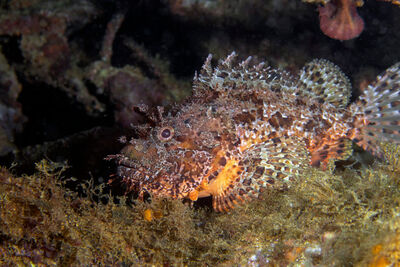With venomous spines and a permanent grumpy expression, the scorpionfish is a creepy creature of the ocean. In our top ten scorpionfish facts, we'll reveal intriguing secrets about these prickly reef dwellers, from camouflage skills that would make a chameleon jealous to a sting that even the toughest sea creatures fear. Read on if you dare…

Masters of disguise
Let's begin with one of the most impressive scorpionfish facts - they take camouflage to an entirely new level. Their rough skin, covered in algae and little bumps, makes them almost indistinguishable from rocks and coral; some species can even change colour to blend in better with their surroundings. This ability helps them to survive longer by avoiding predators, and it works - they can live up to 15 years.
Grumpy faces
Scorpionfish always look like they woke up on the wrong side of the reef. With sagging, downturned mouths, heavy-lidded eyes and rough, wart-covered skin, they appear to be the grumpiest creature in the ocean. However, despite not being admired for their beauty, their odd appearance has gained them fame for being so fascinating.

Prickly by nature
Those spiky dorsal fins aren't just for show; they contain venom that can cause excruciating pain, swelling, nausea and even temporary paralysis in humans. While their stings aren't usually fatal, it's enough to ruin any diver's day.
Diverse diet
If a scorpionfish can fit something in its mouth, it will probably eat it. They're ambush predators who lie in wait for unsuspecting prey (more on that later), eating everything they can get their hands (or fins) on, from small fish, crustaceans and even the occasional unlucky squid. When a scorpionfish is enjoying its meal, there's no chewing involved - they simply suck in their prey in and swallow it whole.

Stealth, not speed
Unlike barracudas or great white sharks, which actively chase down their meals, scorpionfish prefer a more laid-back approach. They rely on ambush tactics to catch their food, remaining perfectly motionless until an unsuspecting fish floats too close. Then, in a split second, their massive mouth shoots forward, and it's all over before the prey even realises what happened.
Glow in the dark
One of our favourite scorpionfish facts is that they can glow in the dark. Some scorpionfish species exhibit biofluorescence, meaning they can absorb light and re-emit it as a glowing red and green. Scientists don't know exactly why they do this, theorising it may be to communicate, hunt or simply because glowing in the dark is an impressive talent in itself.

Not just deep-sea creatures
Scorpionfish can live in surprisingly shallow waters. While some scorpionfish species prefer deeper waters, many hang out in the relatively shallow coastal areas in the Red Sea and the Great Barrier Reef, blending in with coral reefs and rocky areas. This makes them a common (and sometimes painful) surprise for unsuspecting snorkellers who step too close.
Related to the stonefish
If scorpionfish seem dangerous, then their cousin, the stonefish, takes things up a notch. Stonefish are the most venomous fish in the world, and they look almost identical to scorpionfish (grumpy seem to run in the family). Both belong to the same family, Scorpaenidae, which basically means spiky, painful and best admired from a distance.

Range of sizes
While some scorpionfish can grow over a foot long, others, like the pygmy scorpionfish, barely reach a few inches. But don't be fooled by their size - they still have the same venomous spine and deadly hunting skills as their bigger relatives. Small but mighty indeed.
Good parents
Despite their grumpy nature, scorpionfish are surprisingly good parents. While many fish lay their eggs and leave them to fend for themselves, some scorpionfish take a more protective approach. Certain females guard their eggs, watching over them closely until they hatch. In the cutthroat fish-eat-fish world of the ocean, where so many creatures abandon their young, this level of parental care is admirable.
















